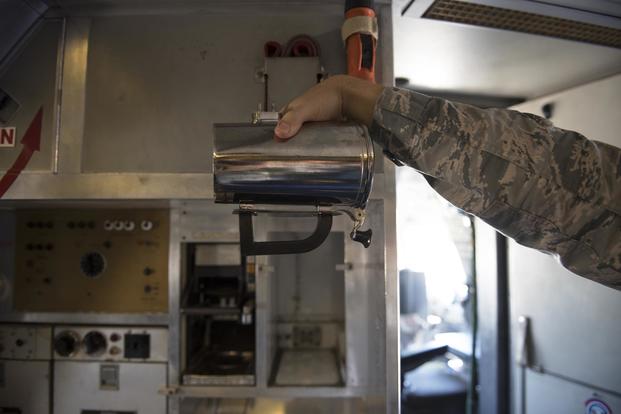Even at the lower price of $693/cup, the legitimate question remains, why in the #$%& are we paying almost $700 for a freaking coffee cup??? There MUST be ways to utilize existing products and/or technology to buy COFFEE CUPS that would be acceptable for use. I’m glad they can replacing handles cheaply, but the cost of the cups themselves is still the issue. This appears to be like the infamous $600 hammers, and the $1,000 Mr. Coffee coffee makers. And people wonder why we can’t afford to buy new military hardware…
+
Air Force’s $1,200 Coffee Cups Could Last Longer Thanks to 3D Printing

The U.S. Air Force has spent thousands of dollars — $56,000 over the last three years, to be exact — on cups that can reheat coffee and tea on air refueling tankers.
No, not a fancy “Game of Thrones”-like chalice adorned with jewels. Just a regular, old-fashioned metal cup.
But the pricey cups are fragile and often break when dropped. Airmen at Travis Air Force Base, California, are working on the problem, according to a service release.
Travis’ Phoenix Spark program is a rapid innovation office using artificial intelligence and rapid prototyping to bridge gaps that currently exist across the force.
“The handle currently on the hot cup has a square bottom, which creates a weak point on the handle so any time it is dropped, the handle splits shortly after impact,” said Nicholas Wright, a volunteer 3D designer and printer with the Phoenix Spark office.
Wright is helping create a prototype for a new handle to replace the flimsy, existing version.
“Our new rounded handle reduces that weak point. The handle we designed is stronger and capable of being printed at most Air Force bases,” he said in the release.
According to Air Mobility Command officials, the 60th Aerial Port Squadron purchased 10 hot cups for $9,630 in 2016. The price for each cup surged from $693 to $1,220 in 2018, resulting in a cost of $32,000 for 25 cups — a price jump of $527 per cup, the release said.
Part of the issue, officials said, is that replacement parts for the cup handle are no longer available. Each time a handle breaks, the Air Force must order a new cup.
“Unfortunately, we can’t order replacement parts when the handle breaks, which requires us to purchase a whole new hot cup every time one breaks,” said 1st Lt. Dennis Abramov, 60th APS passenger operations flight commander.
“The hot cup problem was shared with us because the price keeps increasing,” added Capt. Ryan McGuire, 60th Air Mobility Wing Phoenix Spark chief and a KC-10 Extender pilot with the 9th Air Refueling Squadron. “Our office was asked to see if we could produce a 3D-designed handle that is stronger than the current one.”
Wright compared the 3D-printed handle to a tree, layered through many rings to give it strength. “The new handle has stacked layers with a solid piece around it so it’s similar to the layers of a tree,” he said.
Each 3D-printed handle will cost roughly 50 cents.
“It’s much cheaper for us to replace the handle on 40 cups at about 50 cents per handle rather than purchasing 40 cups for more than $1,200 per cup,” he said.
Wright said it took about a week to develop a solution for the hot cup handle “from learning the software to figuring how to physically print it.”
“We talked to air crew members about how they’d like it designed. They recommended a more ergonomic design. The reason for this is because the original handle is placed upside down, so aircrews wanted a mix between comfort and strength. We achieved that in about seven days,” he said.
The Air Force is awaiting approval from the Air Force Life Cycle Management Center at Wright-Patterson Air Force Base, Ohio, to start printing and fielding cup handle parts.
“They are working through all the processes, quality standards and materials to try and put out a playbook on how we can 3D print the handle so it’s approved to be on an Air Force aircraft,” McGuire said. “Once we get that guidance, we can print the handles at Travis.”
While the Air Force has tried to do more with 3D printing experimentation, it often runs into obstacles.
Assistant Secretary of the Air Force for Acquisition, Technology and Logistics Will Roper recently told DefenseOne the service could do more with 3D-printed parts.
But it doesn’t inherently own the rights to manufacture specific components, he said. Nor does it have a surefire way of dealing with that kind of intellectual property.
Taxpayers are paying a high price as a result, he said.
For example, Roper said he could 3D print new toilet seat covers for C-17 Globemaster IIIs at a cost of roughly $300 per seat. But because the manufacturer owns the rights, the service must rely on industry to produce the item at a whopping $10,000 per seat.
“You’ll think, ‘There’s no way it costs that,’ ” Roper told DefenseOne last month. “No, it doesn’t, but you’re asking a company to produce it and they’re [busy] producing something else.”
— Oriana Pawlyk can be reached at oriana.pawlyk@military.com. Follow her on Twitter at @Oriana0214.
Filed under: Military, National Defense | Tagged: 3D Printing, abuse, coffee cup, fleecing, fraud, fraud waste abuse, government contracting, KC-10, Travis Air Force Base, waste |



Leave a comment